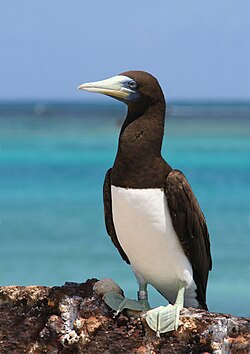Guano mining
In the 19th century, the Lacepede Islands were among numerous islands off the Western Australian coast that were mined for guano. Although much of the guano mined was by Western Australian industry, there was also extensive unauthorised mining by trading ships from other countries, especially the United States. A Melbourne company, Messrs. Poole, Picken and Co., had been authorised by the Western Australian government to load guano, and had been charged a royalty of 10 shillings per ton. [10] On 26 June 1876, a dispute arose when Gilbert Carver Roberts, on behalf of Samuel Lord, an American merchant and honorary US vice consul in Melbourne, landed from the French-flagged barque de Forcade la Roquette, disputed a demand that he pay a levy for mining and attempted to evict the Victorian guano miners licensed by the Western Australian government. [11] Charles Robert Baldwin planted the United States flag on one of the islands, claiming the island group for that country in accordance with the United States Guano Islands Act that empowered U.S. citizens to take possession of uninhabited islands more than a league (three miles) offshore from any country, so long as they had not been formally claimed. [12] This action, known as the "American Incident" or "Lacepede Islands Incident", sparked a diplomatic and political row, which was eventually resolved by Captain Alexander of the de Forcade la Roquette paying the levy and a fine, and the Western Australian government enacting legislation requiring all guano mining to be licensed, with severe penalties for transgressions. In May 1877 Governor Robinson received advice that US President Ulysses Grant had repudiated Lord's annexation. [3] [13] [14] [15] The extraction of guano was wound down in 1879 when the schooner Aurora removed the machinery used for extraction. The manager Captain R McEachern estimated that the quantity of guano left on the islands was less than 2000 tons. [16]


